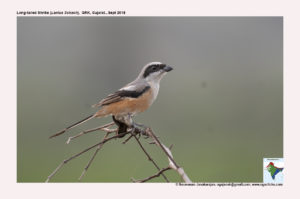Long-tailed Shrike

Long-tailed Shrike Lanius schach
Etymology :
- Lanius : Latin word for Butcher . They are known as ‘butcher-birds,’ from their habit of storing prey by impaling it on thorns and sharp twigs, giving the resemblance to a butcher’s slaughterhouse
- Schach: Onomatopoeic name Scackcoined for theLong-tailed Shrike
Vernacular names: Hindi: Mattiyalatora, Kajalalatora, Sans: Aarakta-prushthalatushak, Kash: Hara watuj, Pun: Latora, M.P: Majhlalatora, Lepcha: Sakrik pho,Guj: Kathiawadilatora, Motiyolatoro, Mar: Naklyakhatik, Khatik, Ta: Kattukuruvi, Peykuruvi, Te: Yerralilinchi, Chinnakiritigadu, Kan: Kandukalinga
Distribution in India: Widespread resident, Winters in Easter coast of the peninsular and North east India.
Description: Size of 22-25 cm . Nominate race has forehead and facial mask ,black crown to dark grey mantle, back and rump rufous; upper wing blackish, tertials edged pale buffish-white, secondaries narrowly tipped pale, conspicuous white patch at base of primaries; tail black, tipped white, outer retrices edged pale buff; throat white, underparts whitish, strongly tinged with rufous on side of breast and flanks, iris dark brown; bill black, paler towards base of lower mandible; legs greyish-black. Both the sexesare similar, female legs somewhat browner than male.
Habitat:It is found in open country with scrub, light woodland and bushes, mainly in cultivated areas, also steppe and semi-desert, grassland with scattered bushes, young plantations, gardens, parks, occasionally edges of evergreen forest
Food Habits:It is an opportunistic feeder. Eats a wide variety of insects e.g. grasshoppers and crickets and beetles. Also eats vertebrates such as small mammals, lizards, frogs, crabs and small birds, including nestlings. Very bold and fearless. Hunts from prominent perch; takes most of its prey on ground, but also hawks insects in air; hops on ground. Occasionally steals food from other birds. Impales some of its victims
Breeding Habits: They breed in April-May. The nest is built by both sexes. It is a bulky open cup made from grasses, thorny twigs, moss, roots and leaves, often man-made materials incorporated, lined with finer grasses and the like, placed in thorny bush or in tree, locally in reeds or tall grass. They lay a clutch of 2–6 eggs, replacement clutches frequent if earlier ones lost; incubation is done by female for a period 13–16 days. The nestling period is 14–17 days; juveniles remain in natal territory for up to 2 months. The nest is regularly parasitized by cuckoos